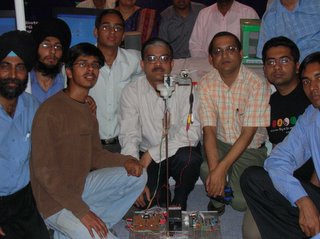India has positioned itself nicely as a major software development center. We could achieve this position due to our inherent strengths in mathematics, which was leveraged appropriately in software engineering, due to the availability of a level playing field in terms of available computing platforms to the masses (cheap PCs).
The same cannot be said of other fields of engineering, namely electronics hardware. There are a few reasons for this situation. The prime reason has been the unavailability of level playing field in terms of cutting edge technology and tools, since the required technology and tools in the field of electronics hardware development require high capital cost. The government has been lacking in ideas and planning in this direction on one hand, while the industry has been subservient in its approach towards building a state of the art industry, pushing itself as a mere screw-driver industry and the academia has been a moot spectator for want of funds as well as a lack of vociferous demand for the required inputs. The academia is also guilty of lacking in ideas and grooming students who are interested in hardware development. Further damage was done to the possible prospects of building a world-class hardware industry, as graduate engineers were and are being lured into management fields as well as the increasing demands of the software industry guzzling up and poaching bright hardware trained engineers. That the dot com bubble burst a few years ago was a welcome event, though, in a short term it did reduce employment prospects of the graduating engineers.
However, since that time, there has been renewed interest amongst the students of electronics engineering streams to seek appropriate jobs. However, a lot needs to be done to promote India as a development center in the field of electronics hardware.
One of the major opportunity that educational institutes have in promoting interest in hardware aspects of electronics, is to relate the fields of study with needs of the masses and the general availability of high tech tools in use in common everyday life. One method would be to promote hobby fields related to electronics hardware amongst the students. One such hobby is in the field of robotics and another is in the field of Ham Radio (Amateur Radio). By involving the students in these hobbies, in the early part of their training in an engineering college, their interest can be captured, retained and cultivated. It is more than likely, that such students would grow up and contribute in these fields, which are core fields of electronics hardware industry, since modern robotics and Ham radio uses embedded computers, communications and microelectronics.
To be able to attract students to such hobbies, it is pertinent that the faculty itself should be interested in these fields, to begin with.
At a more formal level, the electronics-engineering curriculum can insist upon mandatory hardware oriented projects as part of the final year projects and a zero tolerance towards pure software or pure simulation based projects. In this direction, the industry can contribute tremendously, instead of paying just a lip service, as is currently the situation.
The academia, on their part should create a task force to identify fields, which have potential as future technologies, and cultivate and promote researchers and students in those fields.
The faculty in engineering colleges is woefully inadequately equipped to appreciate and handle available high technology. How many faculty members in colleges have access to computers on a 24x7 basis, leave alone access to a laptop or a PDA? The management of these colleges, and government, managing public institutes should dwell on this aspect and invest sufficient funds in these tools. They must realize that computers, laptops and PDAs are not items of luxury, but tools that not only promote efficiency, but also have the potential of germinating new ideas in the field of electronics hardware.
These educational institutes should seriously identify faculty members with industrial experience and tap their potential and expertise to create local development centers to help and augment the efforts of the industry. These development centers should use student population to develop ideas and prototypes. The educational institutes should also think seriously towards creating incubation centers for developing technologies by graduating students. These incubation centers should not only provide seed money but also share the capital equipment in an institute.
There has to be a paradigm shift in the way an engineering faculty member can share his experience with the industry. Currently, the educational institutes restrict and regulate the financial aspects of these activities, which demoralize an interested faculty member. The institutes should promote hands-on industrial activities by faculty members, which will go a long way in establishing India as a major hub of electronics hardware development.
Dhananjay V. Gadre




